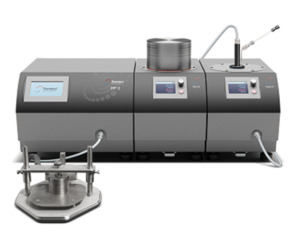Products Details
Thermal Conductivity of PEEK
Thermal Conductivity of PEEK is a high-performance, rigid thermoplastic materials with many versatile characteristics. PEEK has remarkable physical and mechanical properties, resistance to wear, and high temperatures. It is one of the most resilient and highly sought-after thermoplastic materials available. PEEK has been developed to meet the needs of many different applications. It has good thermal stability, and resistance to chemicals, and can be used up to 250ᵒC for long periods of time.
The applications of polymers are endless in a wide range of applications from structural materials to electronics. In this application, we will be measuring the thermal conductivity (W/m·K), thermal diffusivity (mm2/s), and volumetric specific heat (MJ/m3K) of PEEK thermoplastic in the asymmetric configuration.
Equipment and Materials
A single sample of PEEK was measured for thermal conductivity (W/m·K), thermal diffusivity (mm2/s), and volumetric specific heat (MJ/m3K) using the MP-1 Transient Plane Source (TPS) Method: Standard Module. The MP-1 with TPS Standard Module measures the average or bulk thermal conductivity and thermal diffusivity of isotropic materials. This material was measured in the asymmetric configuration with calcium silicate as the backing material.
PEEK
PEEK, a colourless thermoplastic polymer, is used in many different engineering applications. A thermoplastic polymer is a polymer that becomes pliable or mouldable at certain elevated temperatures and then solidifies upon cooling. As a high temperature-resistant thermoplastic material, it can retain its mechanical strength at such high temperatures. It has a glass transition temperature of 143ᵒC and can withstand working temperatures up to 300ᵒC but can be used continuously at high temperatures of 250ᵒC. These high-temperature properties of PEEK make it ideal for many different engineering and industrial applications such as the manufacturing of many different types of high-performance equipment in the automotive, aerospace, biomedical, and engineering applications.

Figure 1. PEEK sample in the asymmetric TPS configuration with calcium silicate backing.
Measurement Platform-1 (MP-1)
The MP-1 is designed to test the absolute thermal conductivity, thermal diffusivity and specific heat of solids, liquids, pastes and powders with the powerful combination of the transient plane source (TPS, ISO 22007-2) and transient hot-wire (THW, ASTM D7896-19) methods.
When measuring the thermal properties of a material using the TPS Standard method, the TPS sensor is placed between two sample pieces for symmetric configuration or between the sample and known backing insulation for asymmetric configuration, each with plane surfaces facing the sensor. The solution to the thermal conductivity equation assumes the sensor is in an infinite medium, so the measurement and subsequent analysis of data must account for the available sample size and limitations created by the outer boundaries of the sample.
Thermal Conductivity of PEEK
The PEEK sample was measured in the asymmetric configuration using the standard 6.4mm radius double spiral TPS sensor (3317-1) with calcium silicate as the backing material. With the Automated Sensor Selection feature, the MP-1 recommends the appropriate sensor to use based on the dimensions of the sample. The 3317-1 sensor was selected in order to satisfy the TCT of the sample size. Optimal measurement parameters of 80s and 13mW were determined using the proprietary iTransient Plane Source (iTPS) application.
Using the patented TPS Contact Analysis (CA), the contact resistance between the sensor and sample was measured (0.98 x 10-3 m2K/W) and automatically removed. This ensures the best analysis possible is used for calculation.
Table 1. Thermophysical measurements of PEEK thermoplastic polymer.
| Temperature (ᵒC) | Thermal Conductivity (W/m·K) | Thermal Diffusivity (mm2/s) | Volumetric Specific Heat (MJ/m3K) |
23 | 0.294 | 0.206 | 1.37 |
| 0.296 | 0.208 | 1.42 | |
| 0.296 | 0.205 | 1.45 | |
| 0.294 | 0.204 | 1.45 | |
| 0.296 | 0.206 | 1.43 | |
| Mean | 0.295 | 0.206 | 1.42 |
| %RSD | 0.22 | 0.64 | 2.1 |
PEEK, 6.4mm radius (3317-1), 80 sec. 0.013 W, 23°C, n=5.
Conclusion
PEEK is widely used in engineering and industrial applications ranging from electronics to aerospace applications. Its incredible mechanical properties and resistance to high temperatures make it more useful than many other similar polymers on the market.



